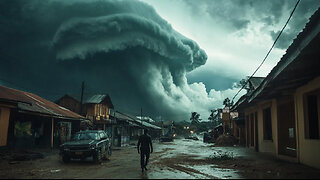Premium Only Content

California NOW! Historic Heatwave Fuels Wildfires: 3,500 Fires And Counting
The unbearably hot start to the summer in many U.S. states has led to a large number of fires. In Oregon, on July 7 at 4:00 PM, a fire named Salt Creek was reported. It erupted about 10 miles east of Eagle Point and was burning on private land and Bureau of Land Management (BLM) land. Within a few hours, the fire's size increased from several acres to hundreds of acres, fueled by "hot, dry, and windy conditions."
Level 1 evacuation ("be ready") was announced in some areas north of Lakecreek and east of Brownsboro, approximately 9 miles east of Eagle Point and 19 miles north of Ashland. The fire danger level in southwest Oregon was raised to "extreme" at noon on Tuesday.
As of July 11, the Salt Creek fire was 16% contained and covered an area of 3,815 acres. About 700 firefighters, 19 engines, nine bulldozers, and 11 water tenders were deployed to extinguish the fire.
On July 4, a fire broke out in the town of Mariposa in the Sierra Nevada, threatening to destroy this popular tourist hub and key gateway to Yosemite National Park. The fire was named the French Fire. The flames erupted in the evening on the northern outskirts of the town and quickly spread across the hills, heading towards the local hospital and school. This forced authorities to issue evacuation orders for about 1,000 residents. The fire cut off Highway 140, the main road to Yosemite. At the time, the park, located 37 miles east of Mariposa, was filled with tourists from around the world and remained open throughout the fire.
Some residents of Mariposa found themselves on the brink of losing their property. They decided to defend their homes by watering their yards with hoses and hoping for a change in the wind. Fortunately, help arrived in time, and firefighters saved the residents and their homes. By noon the next day, with temperatures reaching 107 degrees Fahrenheit, firefighters using bulldozers and helicopters managed to contain the fire, which had covered 908 acres and localized it to 15%. As a result of the fire, at least 11 structures were damaged or destroyed.
Several firefighters sustained minor injuries, but none required hospitalization. As of Sunday, the fire was 60% contained, and evacuation warnings and orders were lifted in residential areas. The popular highway leading to Yosemite National Park was also no longer affected by the wildfire and was reopened to traffic.
Another major fire of the season in California, the Lake Fire, broke out in Santa Barbara County. It started on Friday, July 5, around noon near Lake Zaca in the Los Padres National Forest, about 40 miles north of Santa Barbara. By the next evening, the fire was out of control. Strong winds and extreme heat contributed to the rapid spread of the fire. Evacuation orders were issued in Santa Barbara County, covering the neighborhood where Michael Jackson's former ranch is located. This fact initially drew attention to the Lake Fire.
By Wednesday, the fire had grown to 34,000 acres. A statement from Cal Fire reported that strong fire activity in the southeast of the burn area caused additional evacuations and increased the fire's size.
The Vista Fire started in the San Bernardino National Forest near Mount Baldy on Sunday, July 7, in the morning. As a precaution, evacuation orders were issued for the Mount Baldy ski resort. The fire also led to the closure of hiking trails in the area. Firefighters are finding it difficult to create a containment line as the fire is raging on steep and rocky terrain. The situation is further complicated by triple-digit temperatures.
This may seem counterintuitive, but the large amount of rainfall over the last two rainy seasons, which helped alleviate the state's drought, also contributed to the increase in fires. The rain spurred rapid growth of grass and shrubs. But the dangerous heat, with temperatures reaching up to 110 degrees and higher in some areas of the East Bay, Central Valley, Sierra Nevada, and Southern California, quickly dried out the landscape, creating vast amounts of fuel for the fire. The heat also makes firefighting efforts more challenging. Imagine hiking through the most remote mountainous areas, carrying heavy equipment, with smoke filling the air, flames approaching, and temperatures already above 90 degrees. Unusually high nighttime temperatures further complicate the situation. All this is happening before the peak fire season in the southern U.S.
Climate anomalies have not only become more frequent but also occur simultaneously, amplifying each other and increasing negative impacts.
It is now extremely important to unite the world's leading scientists to find a truly effective solution capable of stopping climate catastrophes and preventing the loss of life on our planet. You can find more detailed information about this on the forum "Global Crisis. The Responsibility".
https://youtube.com/live/xzm_sYcm5t4?feature=share
-
 6:19
6:19
AllatRa TV
11 days agoAfrica NOW! Aftermath of Cyclone Dikeleidi: Mayotte, Madagascar, and Mozambique
97 -
 LIVE
LIVE
Dr Disrespect
3 hours ago🔴LIVE - DR DISRESPECT - MARVEL RIVALS - LOSING MY MIND
3,211 watching -
 1:57:57
1:57:57
The Charlie Kirk Show
2 hours agoTrump's Colombia Masterclass + The Brilliance of VP Vance | Sen. Scott | 1.27.2025
61.1K12 -
 1:08:43
1:08:43
Grant Stinchfield
2 hours ago $1.52 earnedThis is What Leadership Looks Like... America First, Criminals Last!
15.1K9 -

Game On!
3 hours agoThe Super Bowl America Deserves! | Crick's Corner
4.55K2 -
 2:04:10
2:04:10
LFA TV
1 day agoICE ICE BABY! | LIVE FROM AMERICA 1.27.25 11am
48.6K38 -
 1:01:03
1:01:03
The Dan Bongino Show
4 hours agoThe Rock-'Em-Sock-'Em Presidency (Ep. 2409) - 01/27/2025
597K950 -
 1:09:08
1:09:08
The Rubin Report
3 hours agoStephen A. Smith Makes Makes Bill Maher Go Quiet with His Scorching Attack on Democrats
68.3K41 -
 2:01:00
2:01:00
Steven Crowder
5 hours agoWe are So Back: How Trump Flexed American Muscle and Owned Colombia
353K213 -
 1:28:04
1:28:04
Caleb Hammer
3 hours agoHomewrecker Ruins EVERYTHING To Steal Married Old Men | Financial Audit
24.3K6